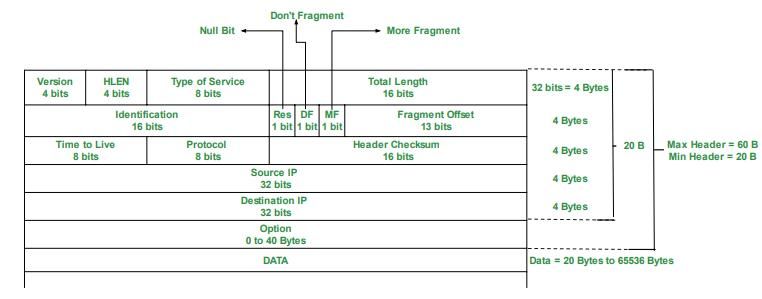IP stands for Internet Protocol and v4 stands for Version Four (IPv4). IPv4 was the primary version brought into action for production within the ARPANET in 1983. IP version four addresses are 32-bit integers which will be expressed in decimal notation. In this article, we will discuss about IPv4 datagram header.
What is IPv4?
IPv4 is a connectionless protocol used for packet-switched networks. Internet Protocol Version 4 (IPv4) is the fourth revision of the Internet Protocol and a widely used protocol in data communication over different kinds of networks. IPv4 is a connectionless protocol used in packet-switched layer networks, such as Ethernet. It provides a logical connection between network devices by providing identification for each device. There are many ways to configure IPv4 with all kinds of devices – including manual and automatic configurations – depending on the network type. IPv4 uses 32-bit addresses for Ethernet communication in five classes: A, B, C, D and E. Classes A, B, and C have a different bit length for addressing the network host. Class D addresses are reserved for multicasting, while class E addresses are reserved for military purposes. IPv4 uses 32-bit (4-byte) addressing, which gives 232 addresses. IPv4 addresses are written in the dot-decimal notation, which comprises four octets of the address expressed individually in decimal and separated by periods, for instance, 192.168.1.5.
Characteristics of IPv4
- IPv4 could be a 32-Bit IP Address.
- IPv4 could be a numeric address, and its bits are separated by a dot.
- The number of header fields is twelve and the length of the header field is twenty.
- It has Unicast, broadcast, and multicast style of addresses.
- IPv4 supports VLSM (Virtual Length Subnet Mask).
- IPv4 uses the Post Address Resolution Protocol to map to the MAC address.
- RIP may be a routing protocol supported by the routed daemon.
- Networks ought to be designed either manually or with DHCP.
- Packet fragmentation permits from routers and causing host.
IPv4 Datagram Header
- VERSION: Version of the IP protocol (4 bits), which is 4 for IPv4
- HLEN: IP header length (4 bits), which is the number of 32 bit words in the header. The minimum value for this field is 5 and the maximum is 15.
- Type of service: Low Delay, High Throughput, Reliability (8 bits)
- Total Length: Length of header + Data (16 bits), which has a minimum value 20 bytes and the maximum is 65,535 bytes.
- Identification: Unique Packet Id for identifying the group of fragments of a single IP datagram (16 bits)
- Flags: 3 flags of 1 bit each : reserved bit (must be zero), do not fragment flag, more fragments flag (same order)
- Fragment Offset: Represents the number of Data Bytes ahead of the particular fragment in the particular Datagram. Specified in terms of number of 8 bytes, which has the maximum value of 65,528 bytes.
- Time to live: Datagram’s lifetime (8 bits), It prevents the datagram to loop through the network by restricting the number of Hops taken by a Packet before delivering to the Destination.
- Protocol: Name of the protocol to which the data is to be passed (8 bits)
- Header Checksum: 16 bits header checksum for checking errors in the datagram header
- Source IP address: 32 bits IP address of the sender
- Destination IP address: 32 bits IP address of the receiver
- Option: Optional information such as source route, record route. Used by the Network administrator to check whether a path is working or not.
 IPv4 Datagram Header
IPv4 Datagram Header
Due to the presence of options, the size of the datagram header can be of variable length (20 bytes to 60 bytes).
Conclusion
Finally, the IPv4 datagram header is a critical component of the Internet Protocol Version 4, allowing data to be routed and delivered across networks. The IPv4 header, which includes structured data such as version, header length, type of service, and checksum, facilitates efficient and reliable communication between devices. While optional fields provide flexibility, its fixed and variable-length components adapt to a wide range of networking requirements. Understanding the IPv4 datagram header is critical for network engineers and administrators to effectively manage and optimise data transfer in IPv4-based networks.
